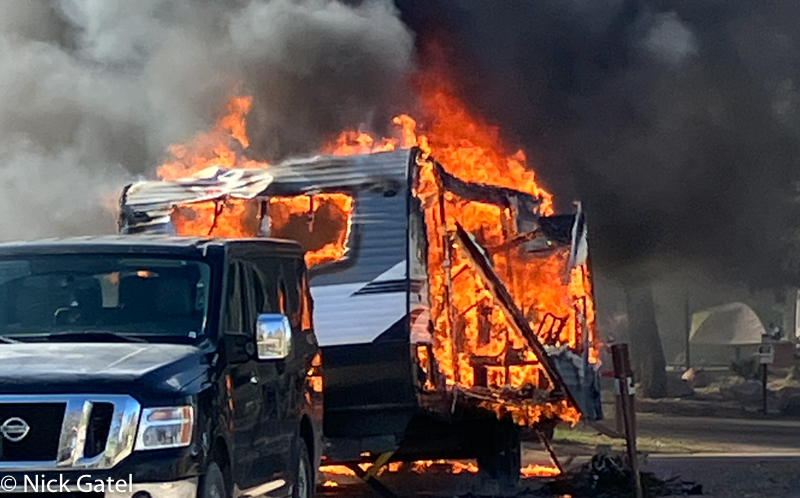
This travel trailer was reduced to ashes in less than 15 minutes.
No one was seriously injured.
I won’t speculate on the cause of the fire, but will share the details as I witnessed them.
Last will be a review of some fire safety reminders that all of us RV owners should follow.
Sequence of Events
March 21, 2024
I was sitting outside our camper, just daydreaming, when I heard a “whoosh-boom.” It was loud and to me sounded like a small explosion. My first thought was a propane leak in our travel trailer. I rushed inside and everything looked normal. Next I walked around the outside of the camper and all was well.
Then I saw smoke just beyond the trees and shrubs at the edge of our campsite. Just across the campsite road, 20 yards from our front door, a travel trailer was on fire. Someone was on a cell phone to 911, two others had fire extinguishers, and a fourth was removing the propane tanks from the front of the burning trailer.
A forest ranger pulled up and told me to move our pick-up truck, which might be endangered. Quickly moving the truck and walking back, the ranger herded everyone away from the fire. There was nothing any of us could do other than watch from a distance.
Using the time stamps of the pictures here is the sequence:
3:36 PM
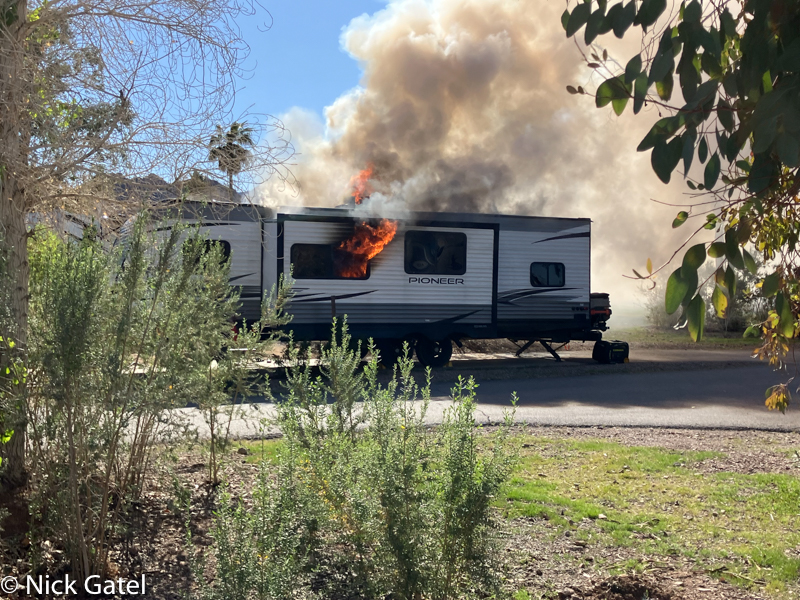
3:39 PM

3:41 PM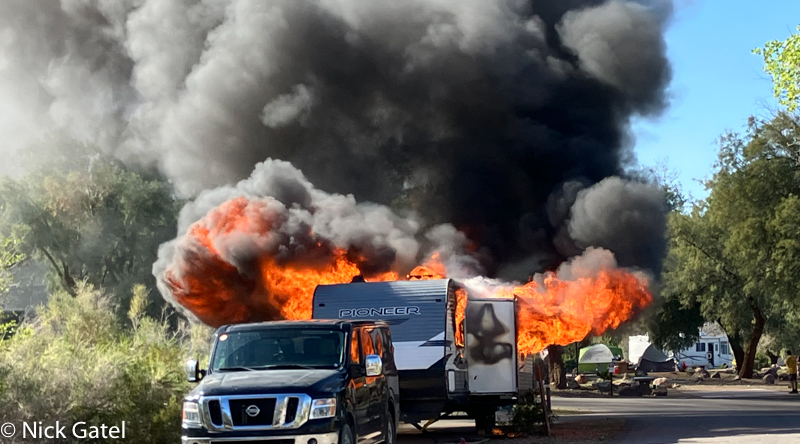
3:42 PM Trailer Totally Engulfed in Fire
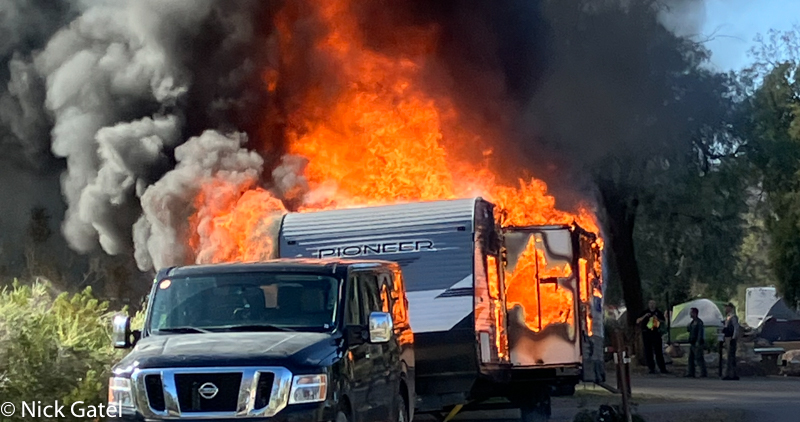
3:48 PM
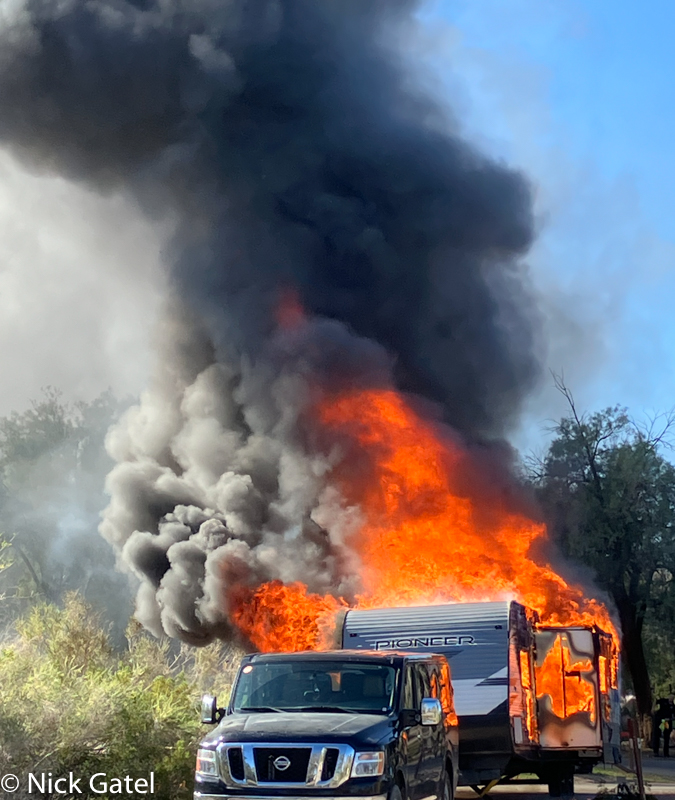
3:49PM Fire Truck Arrives
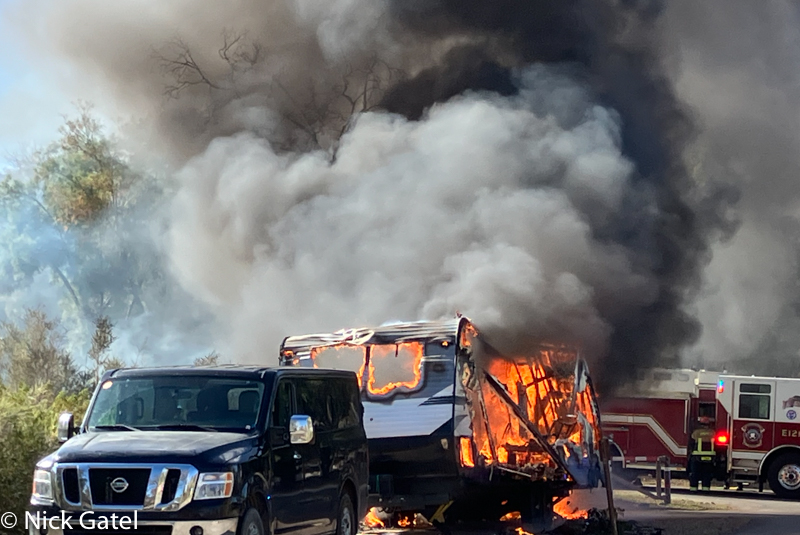
3:51 PM Fire Fighters Battling the Blaze
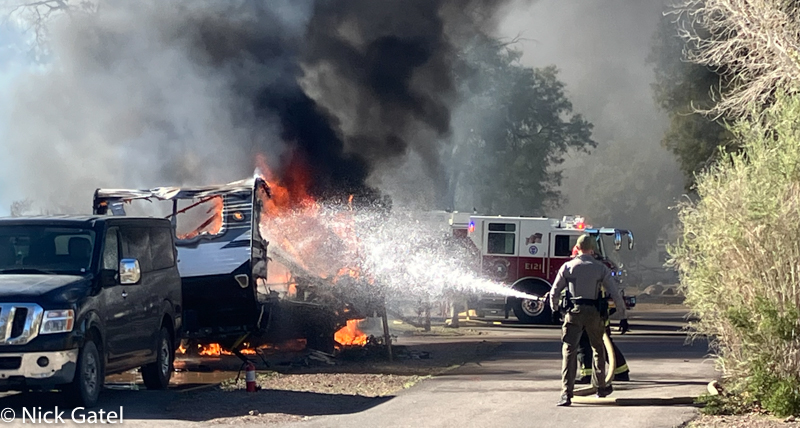
3:59 PM Fire Extinguished
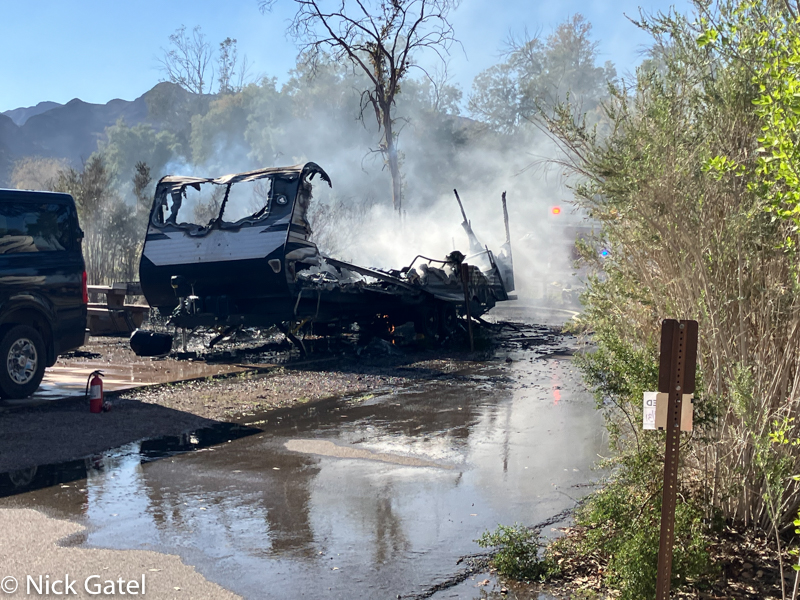
Observations
I was surprised how fast a fire can destroy an RV. If you have worked around them as much as I have, you know they really aren’t that well built.
So this is a reminder that if an RV catches fire there is very little time to escape to safety.
The fire was at a National Park Service Campground close to Boulder City, Nevada. The fire station is about 8 miles from the campground.
I estimate that it took the fire department just under 15 minutes to arrive after the 911 call. Pretty darn quick, considering the call had to be dispatched for 911 to fire department, firefighters had to put on their equipment, get on the truck, and the truck has to navigate 8 miles of roads and traffic including a campground.
A campground isn’t a city. Most public campgrounds we go to don’t have fire hydrants. This campground has a few, although the closest was quite a distance away from the burning RV. Perhaps 1,000 feet away. So it took a couple of minutes to get the water hooked up to the truck.
I was disappointed at the comments from a few people saying the National Park Service is negligent in not installing numerous hydrants throughout the campground — it’s a campground folks!
After the fire was fully contained, the firefighters sprayed some sort of fire retardant via a rather large hose connected to a tank on the truck. Less than 30 minutes from the time the fire started until it was put out.
All-in-all, I was quite impressed with the firefighters. But here is the bottom line — if your RV has a fire and you cannot quickly put out the fire with a fire extinguisher — leave immediately because you can’t save it. Save yourself.
Debris Removal
Two days later a crew arrived to remove the trailer. It couldn’t be towed out. The crew cut the frame into sections with a torch, then loaded the remains into a large refuse truck using a small Caterpillar compact track loader.
Picture of campsite after trailer was removed.
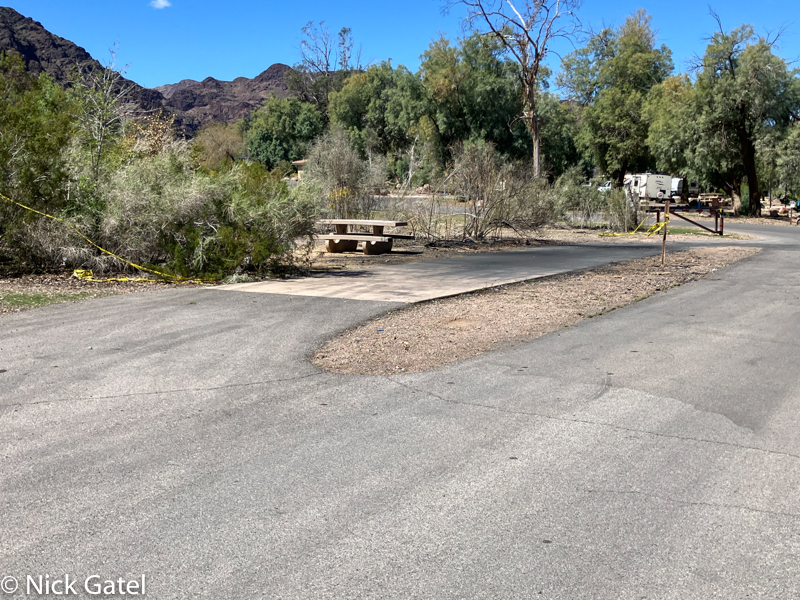
A Fire Safety Reminder
I’ll provide a link provided by the National Park Service for a list of fire safety tips, but first some of the item I think are most important, especially for us.
First & Foremost
Check your fire extinguishers before every trip. If they do not have a built-in gauge, purchase extinguishers that do. Also have at least two. One for each room or area of the RV. Best to have one next to each exit.
Replace (or have them serviced by a professional) at least every 5 years as I wrote about in this post:
One thing that did not occur to me is that there should be an additional fire extinguisher located outside the RV in an unlocked location or in the tow vehicle. I have since purchased a third extinguisher.
This website may be compensated for linking to other sites for sales of products. As an Amazon Associate I earn a small fee from qualifying purchases at no additional cost to the purchaser.
Check the prices on:
First Alert REC5 Recreation Fire Extinguisher
First Alert Bracket for REC5 Fire Extinguisher
Check Smoke Detectors Before Each Trip
Most smoke detectors in RVs are battery operated using 9 volt batteries. It is a good idea to keep spares in your RV as 9V lithium batteries have a shelf life of about 10 years.
You want a smoke detector in each room. Our camper has a separate bedroom so we need two. The camper was manufactured with just one smoke detector near the front door and kitchen area. Additional detectors are inexpensive and simple to install.
Most smoke detectors have an expiration date, usually 10 years. If it has a built-in CO detector, it should be replaced every 7 years. Check your Owner’s Manual.
Check Prices on:
First Alert BRK Lithium Battery Smoke Detector
Tenergy 9V Lithium Batteries, 10 Years Shelf Life
Check Propane/CO Detectors Before Each Trip
These units are not smoke/fire alarms. Most are hardwired into the RVs 12 volt system and will not work if there is a problem with the 12V system. Most have a power light that should always be illuminated. The power light is not a test. The detector must be tested using the “Test Button.”
Note that most Propane/CO leak detectors have a life expectancy of 7-10 years and need to be replaced periodically. Check your Owner’s Manual.
Check the price: Dometic Propane/CO Combination Alarm
Keep Combustible Materials Away From Interior Cooking Area
We usually cook our meals outside because we like to be outdoors as much as possible. Plus a lot of indoor cooking can create lingering odors. We do occasionally use the indoor stove, mostly for making our morning coffee. When using the indoor stove it is usually for things such boiling water, making soup or warming vegetables.
We do not cook anything indoors that can cause a grease fire.
Lastly we keep a couple fire blankets handy.
Check price on: SecuCaptain Emergency Fire Blanket for Home and Kitchen – 2 Pack 40″x40″ Flame Suppression Fiberglass Fire Blankets
Do Not Overload 120 AC Outlets
The most common AC outlets are shallow “self contained” units. They are quick and easy to install during RV assembly. RV electrical wiring is the same type used in houses (Romex). Unfortunately these electrical cables are subjected to vibration and can loosen in the electrical outlets over time.
Most of the faulty RV outlets I have seen are those that power microwaves, hair blow driers and space heaters — high amperage devices.
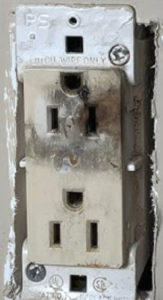
A loose connection in conjunction with a high amperage consumer can result in a fire.
Below are some images of these self-contained electrical outlets:
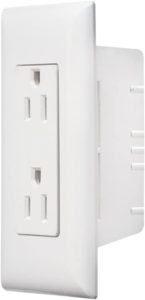
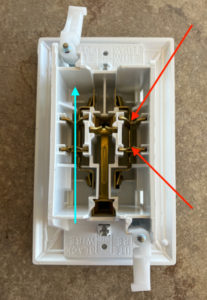
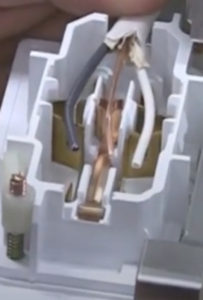

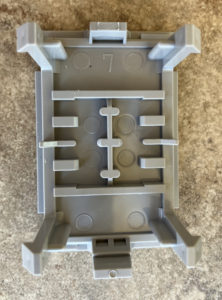
Some RV owners are able to replace a faulty outlet with a quality house style unit, if space permits. Many prefer to use outlets that have screws for wire connections. Keep in mind that screws can loosen over time due to vibration too.
We don’t use our microwave or any high amperage devices like blow driers or space heaters. but if we did, I would only run them at 50% of full power and ensure that the device (at 100% power) does not exceed the amperage rating of the outlet.
Speaking of 120 AC power . . .
Check the AC Power Hook-up
We rarely camp at campgrounds that have electrical hook-ups. I think the last time was over 10 years ago. Of the few I have seen, some don’t look well maintained. If we were to use campgrounds with hook-ups I would invest in a tester before connect our travel trailer. One would want to test for proper polarity and for an under or over voltage supply.
If I were in need of such an item, it is not something I would skimp on price-wise!!
Here are a couple I found on Amazon, but I cannot vouch for their quality since I haven’t used either. Progressive Industries is a well-regarded company.
Progressive Industries 30 Amp RV Surge Protector with Electrical Management System
Progressive Industries 50 Amp RV Surge Protector with Electrical Management System
Check Your 12 Volt System
Make sure the battery cable connections are clean are secure. This includes connections to an inverter if you use one. A loose cable can cause serious problems.
Disconnect Your Tow Vehicle
If you are towing a trailer, unhook it. A RV fire burns quickly and there may not be enough time to unhitch. Plus you might need to escape before you can grab the vehicle keys.
In the RV fire we witnessed, the owner did not have time to grab the keys and they were destroyed in the fire. Fortunately their tow vehicle was not connected. Most trucks have a 30+ gallon fuel tank which could result in a more disastrous fire than the RV.
Leave Your RV Doors Unlocked
Should you be asleep when a fire breaks out, you may not wake up. Open doors would allow rescuers to enter in time to save your life.
I wrote about RV security in this post:
RV Fire Safety 101
Link to National Park Service Article on RV Fire Safety